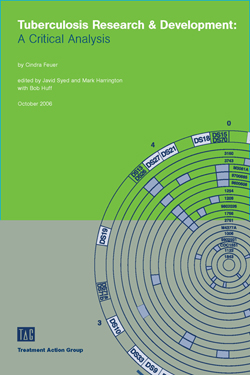Tuberculosis Research & Development: A Critical Analysis
By Cindra Feuer
October 2006 – This report is the product of an effort by the Treatment Action Group (TAG) to ascertain the major funders of tuberculosis (TB) research and development (R&D) in 2005, what kinds of research activity they funded, and how much research activity is already taking place. This assessment will help policymakers, funders, researchers, and advocates understand the current state of research on TB, and it provides a baseline for understanding how much TB research funding will need to increase in order to bring TB under control over the next decade.
TAG’s researcher/writer, Cindra Feuer, assisted by TB/HIV Project Director Javid Syed and I, contacted leading institutions worldwide to determine their TB R&D investments in 2005. Eighty institutions out of 100 provided information. We are grateful to all who provided useful data and responded to, in many cases, repeated queries. Here we are able to provide estimates of the total amount spent on TB R&D by the top 40 donors in 2005—$393 million—and estimates of the relative proportion spent on basic science; applied research on new TB tools including diagnostics, drugs, and vaccines; and operational research to optimize the use of existing interventions in routine program settings.
Though it is an inexact art, a recent bibliometric paper, which assessed outputs and expenditures on health research in eight disease areas, including TB from 1996– 2001, estimated a similar level of investment, $350 million per year (Lewison 2004). It is likely that the bibliometric assessment picked up some operational research in high-burden countries which we did not quantify. Their assessment of industry investment, $28 million, was less than our assessment of $43 million, which counted only the six companies that reported figures to TAG.
The data indicate that investment in TB R&D lags far behind necessary levels. If new tools funding continues at its 2005 level of $206 million, just $2.06 billion will be available for new tools research over the next decade, whereas The Global Plan to Stop TB: 2006–2015 estimates that $9 billion will be needed, revealing a new TB tools funding gap of $6.9 billion. Thus, TB R&D investment needs to increase nearly fivefold to meet The Global Plan targets. Still more is needed to expand basic science and operational research. All this will only come with worldwide political advocacy for a TB research movement with ambitious and comprehensive targets for investment in the basic, applied, and operational research that can make TB history.
To accomplish this, TAG recommends that investors in TB R&D worldwide urgently increase their investments fivefold, from less than $400 million per year, to $2 billion per year, with $1.05 billion directed towards new tools research and $950 million directed towards basic science, infrastructure development, and operational research each year, for a total investment of $20 billion in TB R&D over the coming decade. This will not take place without the creation of a global TB research movement that will coordinate research efforts and funding across various sectors as well as engage stakeholders to raise the political profile of tuberculosis.

